Ditapis dengan
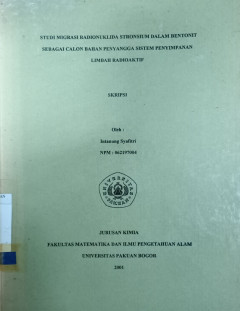
Studi Migrasi Radionuklida Stronsium Dalam Bentonit Sebagai Calon Bahan Penya…
Dalam penelitian ini digunakan metode in-diffusion untuk memperoleh koefisien difusi dinamik sebagai fungsi densitas kering bentonit. Hasil yang diperoleh menunjukkan bahwa dengan variasi densitas , koefisien difusi stronsium yang diperoleh berada 1 orde puluhan lebih rendah dari koefisien difusi tritium. Dari hasil tersebut, maka bentonit dapat digunakan sebagai salah satu bahan penyangga dala…
- Edisi
- -
- ISBN/ISSN
- -
- Deskripsi Fisik
- ix, 50 p. : Illus. ; 30 cm
- Judul Seri
- -
- No. Panggil
- 540 SYA s
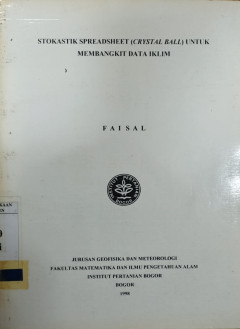
Stokastik Spreadsheet (Crystal Ball) Untuk Membangkit Data Iklim
Stokastik spreadsheet merupakan sheet yang dilengkapi dengan perangkat stokastik sehingga memungkinkan untuk melakukan proses pembangkitan data secara acak dari suatu sebaran yang ditentukan. Penelitian ini ditujukan untuk menyusun model spasial pembangkit data iklim dan mengevaluasi model pembangkit data iklim yang sudah dikembangkan di Indonesia serta pemanfaatan stokastik spreadsheet dalam p…
- Edisi
- -
- ISBN/ISSN
- -
- Deskripsi Fisik
- vii, 12 p. : Illus. ; 30 cm
- Judul Seri
- -
- No. Panggil
- 550 FAI s
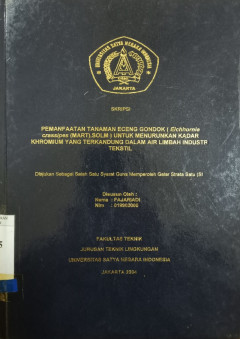
Pemanfaatan Tanaman Eceng Gondok (Eichhornia Crassipes (MART).SOLM) Untuk Men…
Dalam penelitian ini air limbah diambil dari PT. Sahid Detolin Tekstil. Pengolahan air limbah ini menggunakan jumlah eceng gondok yang sama yaitu sebanyak 12 rumpun dan dengan waktu tinggal yang berbeda-beda yaitu 10 hari, 15 hari dan 20 hari. Perlakuan tersebut hasilnya menunjukkan penurunan pada kadar khromium dan pH. Hasil penurunan khromium dari 1.28 mg/l menjadi 0.87 mg/l, sedangkan pH dar…
- Edisi
- -
- ISBN/ISSN
- -
- Deskripsi Fisik
- viii, 49 p. : Illus. ; 12 cm
- Judul Seri
- -
- No. Panggil
- 574.5 FAJ p
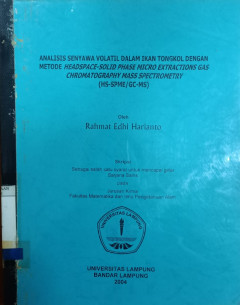
Analisis Senyawa Volatil Dalam Ikan Tongkol Dengan Metode Headspace-solid Pha…
Tujuan penelitian adalah untuk mengembangkan metode SPME untuk analisis sekaligus identifikasi senyawa volatif dalam ikan tongkol serta mempelajari pengaruh waktu penyimpanan terhadap profil senyawa volatil dalam ikan tongkol. (Jml)
- Edisi
- -
- ISBN/ISSN
- -
- Deskripsi Fisik
- iv, 76 p. : Illus. ; 11 cm
- Judul Seri
- -
- No. Panggil
- 540 HAR a

Safety Ragulations and Licencing System for Commercial Nuclear Power Plants i…
-
- Edisi
- -
- ISBN/ISSN
- -
- Deskripsi Fisik
- -
- Judul Seri
- -
- No. Panggil
- -

Karakterisasi Enzim a-Amilase Ekstraseluler Isolat Bakteri Termofil Dari Pusa…
Tujuan penelitian ini adalah untuk mengisolasi dan mengkarakterisasi enzim a-amilase ekstraseluler yang dihasilkan dari isolasi bakteri SW2. Isolasi dilakukan setelah bakteri tersebut difermentasi pada media pati kentang selama 39 jam pada temperatur 60oC, pH 7,5 di dalam shaker incubator yang berkecepatan 150 rpm. Uji karakterisasi enzim meliputi: penentuan temperatur dan pH optimum, penentuan…
- Edisi
- -
- ISBN/ISSN
- -
- Deskripsi Fisik
- xi, 66 p. : Illus. ; 30 cm
- Judul Seri
- -
- No. Panggil
- 540 APR k

Pengaruh Bahan Orfit Terhadap Dosis Kulit Kedalaman 1 mm Pada Penggunaan Pesa…
Orfit adalah salah satu bahan untuk masker, yang mudah dibentuk dari dari segi ekonomisorfit memiliki kemampuan untuk dibentuk kembali sebanyak empat kali, sedangkan limbah dari orfit dapat diuraikan secara alami, sehingga lingkungan aman dari pencemaran bahan orfit. Efek dari penggunaan masker pada terapi radiasi adalah radiasi hambur yang ditimbulkannya, sehingga akan mempengaruhi dosis radia…
- Edisi
- -
- ISBN/ISSN
- -
- Deskripsi Fisik
- xiv, 69 p. : illus. ; 15 cm
- Judul Seri
- -
- No. Panggil
- 530.07 SUN p
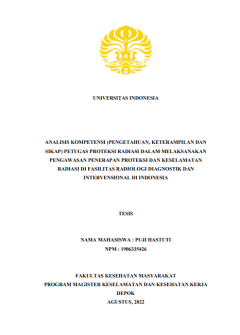
Analisis Kompetensi (Pengetahuan, Keterampilan Dan Sikap) Petugas Proteksi Ra…
International Atomic Energy Agency (IAEA) mengeluarkan rekomendasi kepada badan pengawas untuk menunjuk Petugas Proteksi Radiasi (PPR) yang berkompeten di radiologi diagnostik dan intervensional (RDI). Penelitian bertujuan mengetahui kompetensi (pengetahuan, keterampilan dan sikap) PPR, faktor yang berpengaruh, indikator pengetahuan, keterampilan dan sikap yang signifikan serta hubungan antar v…
- Edisi
- -
- ISBN/ISSN
- -
- Deskripsi Fisik
- 309p;illus
- Judul Seri
- -
- No. Panggil
- 610.7346 HAS A
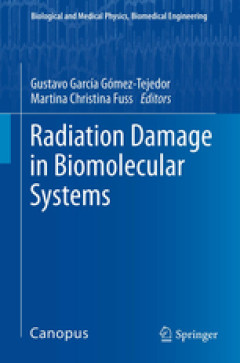
Radiation Damage in Biomolecular Systems
Since the discovery of X-rays and radioactivity, ionizing radiations have been widely applied in medicine both for diagnostic and therapeutic purposes. The risks associated with radiation exposure and handling led to the parallel development of the field of radiation protection. Pioneering experiments done by Sanche and co-workers in 2000 showed that low-energy secondary electrons, which are a…
- Edisi
- -
- ISBN/ISSN
- 9789400725638
- Deskripsi Fisik
- 510 p. : illus. ; 24,5 cm
- Judul Seri
- -
- No. Panggil
- -
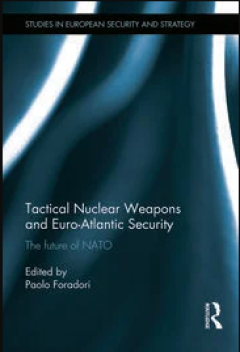
Tactical Nuclear Weapons and Euro-Atlantic Security: The Future of NATO
The use of nuclear weapons in the world is very worrying. Therefore, there is a need for a mutual agreement to maintain world security. This book deals specifically with tactical nuclear weapons and European and Atlantic security. There are 9 chapters including a review of the future of the NATO member agreement on nuclear weapons (MM).
- Edisi
- -
- ISBN/ISSN
- 9780415635349
- Deskripsi Fisik
- 190 p. : illus. ; 24 cm
- Judul Seri
- Studies in European Security and Strategy
- No. Panggil
- 355.0217094 For t
 Karya Umum
Karya Umum  Filsafat
Filsafat  Agama
Agama  Ilmu-ilmu Sosial
Ilmu-ilmu Sosial  Bahasa
Bahasa  Ilmu-ilmu Murni
Ilmu-ilmu Murni  Ilmu-ilmu Terapan
Ilmu-ilmu Terapan  Kesenian, Hiburan, dan Olahraga
Kesenian, Hiburan, dan Olahraga  Kesusastraan
Kesusastraan  Geografi dan Sejarah
Geografi dan Sejarah